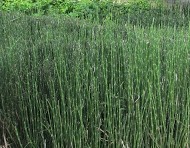 As a member of the Pteriodophyte Divison of plants, the horsetail family has vascular tissue to conduct water and nutrients like flowering plants but reproduces by means of spores rather than seeds. The family was once large and diverse with some species growing into large trees and many contributing to our coal deposits. Today there is only one genus with twenty three species. The members of the horsetail family like moist conditions such as along the margins of rivers or swamps and are widespread but notably absent from Australia and New Zealand. The plants absorb silca from the soil and store it in their cells giving them an abrasive quality. Early settlers used Equisetum hyemale to scour pots and pans giving rise to the common name “scouring rush”. This same species is grown as a garden plant for its strong vertical minimalistic look. The plant spreads by rhizomes and can pop up unexpectedly in nearby places.
As a member of the Pteriodophyte Divison of plants, the horsetail family has vascular tissue to conduct water and nutrients like flowering plants but reproduces by means of spores rather than seeds. The family was once large and diverse with some species growing into large trees and many contributing to our coal deposits. Today there is only one genus with twenty three species. The members of the horsetail family like moist conditions such as along the margins of rivers or swamps and are widespread but notably absent from Australia and New Zealand. The plants absorb silca from the soil and store it in their cells giving them an abrasive quality. Early settlers used Equisetum hyemale to scour pots and pans giving rise to the common name “scouring rush”. This same species is grown as a garden plant for its strong vertical minimalistic look. The plant spreads by rhizomes and can pop up unexpectedly in nearby places.

The distinguishing characteristics of the Horsetail Family are:
-
1. Leaves small and arranged in whorls around the stem.
2. Spores borne in terminal cone-like structures (strobili).
Other characteristics of importance include:
-
1. Spores are wrapped with small bands (elaters) that unwrap and wrap with changes in humidity and carry the spores in the wind.
2. Some stems are sterile and do not bear terminal strobili.

